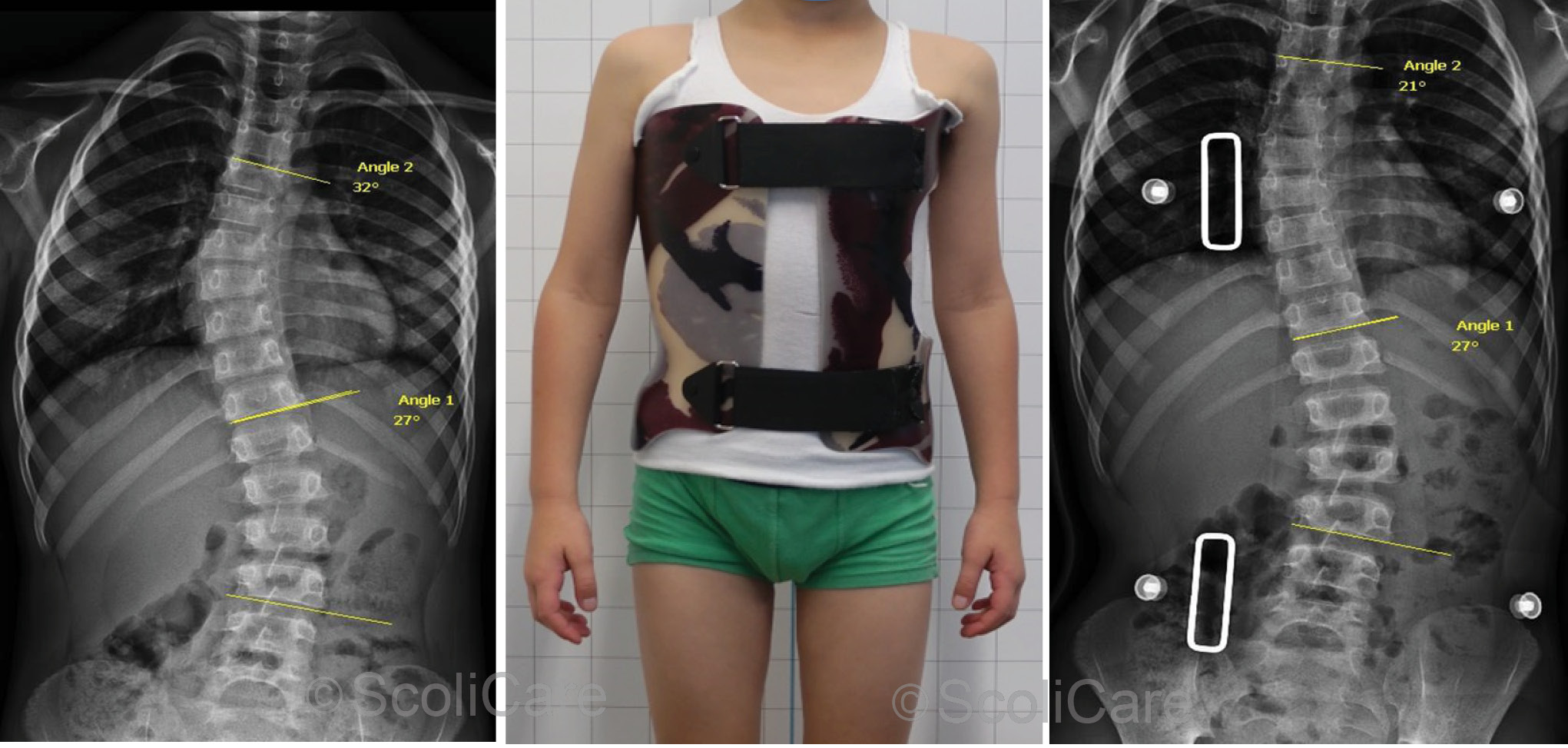Patient aged 7 years with scoliosis thoracic curve measured at 32° and lumbar curve measured at 27°
In-brace correction achieved with a custom 3D designed scoliosis brace compared with a standard TLSO in a juvenile scoliosis patient
Summary:
This case demonstrates the effect of a custom 3D designed scoliosis orthosis compared to a hospital made thoracolumbosacral orthosis (TLSO) in a 7-year-old male with moderate scoliosis. The patient presented with a 32° right thoracic curve and a 27° left lumbar curve that had been braced using a TLSO that was designed and fitted by a hospital orthotist.
The in-brace correction that could be obtained using the hospital made TLSO was very poor and would have been unlikely to alter the natural history of the patient’s scoliosis. A custom scoliosis orthosis was prescribed, which in the initial stages, has provided an in-brace correction far superior to the hospital made TLSO resulting in clinically meaningful changes in the patient’s scoliosis.
Case Background
The male patient had been referred to the ScoliCare clinic at the age of seven with a previous diagnosis of juvenile idiopathic scoliosis. The patient had been fitted with a traditional 3-point pressure thoraco-lumbo-sacral orthosis (TLSO) that had been designed by a hospital orthotist.
Examination Findings
The patient reported that he regularly participated in rugby, soccer and swimming. Aside from the spinal deformity, the patient was otherwise healthy. On examination a right thoracic curve and a left lumbar curve were noted.
The patient had brought along x-rays that had been taken at the time of the initial diagnosis as well as x-rays taken soon after the brace fitting (Figure 1).
The initial pre-brace x-rays revealed that the patient’s primary thoracic curve was 32° Cobb and the secondary lumbar curve was 27° Cobb. An examination of the in-brace x-rays for the hospital made TLSO demonstrated that an adequate in-brace correction had not been achieved with only an 11° reduction in the thoracic curve and no measurable change in the magnitude of the lumbar curve (Figure 1).

Figure 1: Initial pre-brace posterior-anterior x-ray (Left), Patient wearing the hospital made TLSO (middle),
In-brace posterior-anterior x-rays (Right).
Intervention
A customised over-corrective scoliosis orthosis was substituted for the patient’s original hospital-made TLSO.
Outcomes
In-brace x-rays taken soon after the fitting of the new custom brace demonstrated a significantly better in-brace correction compared to the previous brace. The patient’s primary thoracic curve had been reduced to down to 13° Cobb, which represented a 59% correction of the initial curve and a 25% improvement on the correction obtained with the hospital-made TLSO.
The lumbar scoliosis was almost completely reduced (3° Cobb) in the new orthosis. The hospital-made TLSO had not achieved any correction in this region of the spine.
Discussion
The custom 3D over-corrective brace is not a traditional 3-point pressure brace. Instead the brace utilises the concept of spinal repositioning by over-correcting the body posture using specific 3-dimensional moulding to maintain the correction in the brace. Research has demonstrated that significant in-brace corrections (up to 50% curve correction in flexible spines) are required if bracing is to be successful. If this magnitude of correction is not obtained initially, it is unlikely the brace has been adequately designed, manufactured or fitted correctly.
This case demonstrates a distinct difference in the corrective effect, on the same patient, using two different braces. The hospital-made TLSO did not achieve a substantial correction and is less likely to have prevented progression in this case. The other demonstrated a good correction and therefore has a much higher chance of obtaining a successful result.
Conclusion
Not all braces are the same. In this case the custom 3D designed over-corrective brace provided a superior in-brace correction when compared to the hospital-made TLSO for the same patient. Although the subject of this case is still undergoing treatment, the initial requirements required for a positive result for brace treatment have been obtained using the custom orthosis.
NB: Results vary from case to case. Our commitment is to recommend the most appropriate treatment based on the patients type and severity of scoliosis.
© ScoliCare
The post Case – Juvenile Bracing (7 year old patient) appeared first on ScoliCare.
